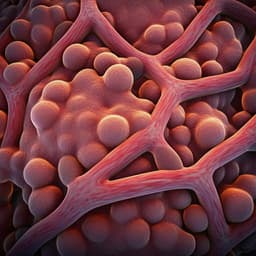
Food Science and Technology
New challenges for efficient usage of *Sargassum fusiforme* for ruminant production
Y. Y. Choi, S. J. Lee, et al.
Discover how *Sargassum fusiforme*, a brown algae, can revolutionize ruminant diets! This research by You Young Choi and colleagues from Gyeongsang National University reveals the algae's potential to enhance nutrient absorption while reducing harmful emissions. Don't miss the chance to learn about this sustainable feed option!
~3 min • Beginner • English
Introduction
Rising interest in algal resources has highlighted their potential as sources of bioactive compounds, biofuels, and animal feeds. In Korea, feed costs can comprise up to 50% of livestock production costs, while Sargassum fusiforme (Hijiki) is produced in large quantities with residual biomass often discarded, posing environmental concerns. Given limited arable land for forage, utilizing algal biomass as a ruminant feed ingredient could reduce costs and mitigate waste. Algae are rich in carbohydrates (60–70%), minerals, and proteins, with S. fusiforme containing polysaccharides (fucoidan, alginate, laminarin, mannitol) that may act as prebiotics and support antimicrobial, antioxidant, and immunomodulatory effects. In ruminants, improving fermentation efficiency and reducing enteric methane can recover up to 15% of dietary energy. Hypothesis: incorporating S. fusiforme into ruminant diets can improve rumen fermentation and reduce methane emissions while providing nutritional value. Objectives: (1) characterize the physicochemical and nutritional profiles of S. fusiforme; (2) determine in situ degradation parameters relative to timothy hay; and (3) assess in vitro effects on gas emissions and fermentation to explore methane mitigation.
Literature Review
Prior studies indicate seaweeds can manipulate rumen fermentation and mitigate methane (e.g., Maia et al., 2016), and have been reviewed as livestock feed ingredients (Makkar et al., 2016). Various seaweeds show differing ruminal and intestinal degradability (Tayyab et al., 2016). Brown algae provide minerals, polysaccharides, and omega-3 fatty acids with potential prebiotic and antimicrobial benefits. Methane mitigation strategies have included algal compounds such as phlorotannins and fatty acids; bromoform in red algae Asparagopsis reduces methane in vitro, and lipids can suppress methanogens. S. fusiforme is known to be rich in carbohydrates (e.g., mannitol) and minerals; however, brown algae can accumulate arsenic predominantly as less toxic arsenosugars. Gaps include limited data on S. fusiforme’s detailed metabolome, fatty acid profile, and direct in vivo effects on methane and productivity.
Methodology
Ethics: Protocol approved by the Animal Care and Use Committee of Gyeongsang National University (GNU-180130-A0007). Raw material preparation: S. fusiforme was collected in March 2018 from Hansan Island (Tongyeong, Korea), rinsed to remove epibionts/sand, dried at 55 °C overnight, cut, and ground (2 mm for in situ; 1 mm for in vitro and chemical analyses). Timothy hay served as a comparator. Chemical analyses: DM, CP, CF, EE, CA per AOAC methods; NDF, ADF, lignin per Van Soest. NFC = 1000 − (CP+EE+CA+NDF); NFE = 1000 − (CP+EE+CA+CF). Minerals and heavy metals by AAS and ICP-OES; Hg by FIMS. Gross energy by bomb calorimetry. In vitro fermentation: Rumen inoculum from two fistulated, non-lactating Hanwoo cows (BW 450 ± 30 kg) fed 60% timothy hay and 40% concentrate. Rumen fluid mixed with McDougall’s buffer (1:2 v/v), maintained anaerobic at 39 °C. Basal substrate timothy hay; S. fusiforme added at 0, 1, 3, 5, or 10% of timothy hay. About 0.300 g substrate placed in nylon bags inside 50 mL serum bottles; 15 mL inoculum dispensed, bottles flushed with N2, sealed, and incubated at 39 °C, 120 rpm for 3, 6, 9, 12, 24, 48, and 72 h; triplicate per treatment. Measurements: Total gas via pressure transducer and lab equation; CH4 and CO2 by GC with TCD and Carboxen 1006 PLOT column. pH measured by pH meter. VFA quantified by HPLC (UV detector; Metacarb 87H column). Microbial growth rate assessed as OD at 550 nm after washing/centrifugation. Protozoa enumerated after 24 h using methylgreen–formalin–saline and hemocytometer; triplicate counts. In vitro DM digestibility estimated via nylon bag method: post-incubation washing and drying at 105 °C, DMD = (DMi − DMf)/DMi × 1000. In situ trial: Nylon bags (pore 50 ± 10 µm) containing 5 g ground timothy hay or S. fusiforme incubated in rumen for 6, 12, 24, 48, 72 h (triplicates). Bags washed and dried at 65 °C to constant weight. DMD fitted to Ørskov and McDonald model P = a + b(1 − e−ct); ERD = a + b(c/(c + p)) with p = 0.04 h−1. 1H-NMR metabolomics: Freeze-dried S. fusiforme extracted with methanol-d4, phosphate buffer in D2O, and TSP internal standard; sonication and centrifugation; spectra acquired on 800 MHz NMR with TCI cryoprobe; processed in Chenomx NMR Suite 8.4 for metabolite identification/quantification. Statistics: One-way ANOVA (GLM, SAS 9.4) for completely randomized design; Tukey’s test for multiple comparisons; linear and quadratic contrasts across doses; significance at P < 0.05. Pearson correlations for methane vs VFA; diagnostics via PRESS, Durbin–Watson, Kolmogorov–Smirnov, and constant variance tests; SigmaPlot for regression.
Key Findings
Chemical composition: Compared with timothy hay, S. fusiforme had high moisture (as-raw 870.6 ± 7.44 g/kg; DM basis 74.8 ± 0.75 g/kg), high crude ash (416.2 ± 15.68 g/kg DM), NFE (430.1 ± 18.48 g/kg DM), NFC (291.0 ± 13.37 g/kg DM), and lower NDF (195.8 ± 1.86 g/kg DM), ADF (130.3 ± 4.84 g/kg DM), EE (6.3 ± 0.68 g/kg DM), CF (56.7 ± 3.69 g/kg DM), and gross energy (10.6 ± 0.12 MJ/kg DM). Minerals: High salinity (87.4 ± 3.94 g/kg DM), chloride (130.05 ± 7.69 g/kg DM), sodium (34.40 ± 0.90 g/kg DM). Trace minerals included Fe 91.41 ± 5.42 mg/kg DM, Zn 24.53 ± 0.87 mg/kg DM, Mn 10.66 ± 0.30 mg/kg DM. Heavy metals: Arsenic 94.17 ± 4.96 mg/kg DM (highest); cadmium 0.53 ± 0.04 mg/kg DM (lowest); Co and Hg not detected. In vitro fermentation: pH remained within 5.65–7.24 without significant treatment effects overall. DM digestibility showed time- and dose-dependent responses: at 3 h, S. fusiforme increased DMD vs 0% (P = 0.0093); at 24 h, DMD decreased linearly with S. fusiforme dose (P = 0.0027; quadratic P = 0.0135), with 1% and 10% showing lower values than 0%. Microbial growth rate: at 9 h, 1% and 10% increased OD vs 0% (P = 0.0360). VFA production: at 12 and 24 h, 1% and 10% S. fusiforme increased total VFA (linear P = 0.0089 and 0.0267), acetate (linear P = 0.0085 and 0.0189), propionate (quadratic P = 0.0169), and butyrate (quadratic P = 0.0046) vs 0%. Protozoa: counts at 24 h decreased linearly with S. fusiforme dose (P = 0.0020), indicating anti-protozoal effects. Gas profiles: Total gas reduced at 3 h (treatment P < 0.0001; linear P = 0.0016; quadratic P < 0.0001) and at 24 h (treatment P = 0.0003) at certain doses (notably 1% and 10%) vs 0%; effects diminished by 48–72 h. Methane: reduced at 3 h (linear P < 0.0001; treatment P < 0.0001) and at 24 h (treatment P = 0.0003), with 1% and 10% significantly lower than 0% (e.g., 24 h: 8.38 vs 4.86–5.92 mL g−1 DM). Carbon dioxide: reduced at 3 h (treatment and linear P < 0.0001) and 24 h (treatment P < 0.0001; linear P = 0.0015). Correlations: Methane positively correlated with total VFA (R² = 0.6406, P < 0.001) and propionate (R² = 0.6087, P < 0.001). In situ degradability: S. fusiforme showed higher DMD than timothy hay at early–mid times (6–24 h; P ≤ 0.0002), converging by 48–72 h. Degradation parameters (g/kg DM): S. fusiforme a = 443.02 (vs timothy 128.58), b = 323.41 (vs 640.64), c = 1.12 h−1 (vs 2.14 h−1). ERD at p = 0.04 h−1: S. fusiforme 513.80 vs timothy 454.70 g/kg DM. Metabolomics (1H-NMR): 31 metabolites across 7 classes identified; highest concentrations included mannitol 25.84 ± 1.57 mM, guanidoacetate 14.12 ± 1.03 mM, ethylene glycol 2.75 ± 0.24 mM; abundant carbohydrates, amino acids (alanine, aspartate, methionine), and organic compounds (e.g., taurine, allantoin). Safety: Despite elevated arsenic, levels deemed within allowable limits for ruminants; predominance likely as organic arsenosugars.
Discussion
The study demonstrates that S. fusiforme can modulate rumen fermentation by increasing VFA production (including propionate) and, at early time points (3 and 24 h), suppress methane and carbon dioxide emissions without severe disruption of rumen pH. The higher early in situ degradability and large rapidly soluble fraction (a) indicate that S. fusiforme provides readily available substrates (notably NFC and soluble carbohydrates like mannitol) to rumen microbes, enhancing early fermentation and microbial growth. Anti-protozoal effects observed at 24 h align with potential roles of phlorotannins and other algal phenolics, which can indirectly reduce methanogenesis given protozoa–methanogen associations. Potential mechanisms for methane reduction include: (i) nitrogenous compounds altering acid–base mediated gas release; (ii) phlorotannins reducing protozoa and shifting microbial consortia; and (iii) fatty acids from S. fusiforme exerting toxic effects on methanogens. Positive correlations between methane and total VFA/propionate reflect the general linkage between fermentative activity and gas production; yet the observed methane suppression at specific doses/time points suggests targeted antimethanogenic effects outweigh baseline fermentation-driven gas evolution early on. Mineral richness supports nutritional adequacy, though high salinity recommends pre-use washing. Heavy metal content, particularly arsenic, necessitates attention to speciation and monitoring, but likely low bioavailability (arsenosugars) mitigates acute toxicity risks in ruminants. Collectively, results support the hypothesis that S. fusiforme can serve as a nutritionally valuable feed component while contributing to methane mitigation, especially during early fermentation, though effects attenuate by 48–72 h.
Conclusion
Sargassum fusiforme shows promise as an alternative, renewable feed ingredient for ruminants. It provides readily fermentable carbohydrates and minerals, increases VFA production, reduces protozoal counts, and suppresses methane and CO2 emissions at early incubation stages. In situ data indicate high rapidly soluble fractions and favorable effective rumen degradability compared with timothy hay. Metabolomic profiling revealed abundant mannitol and other bioactive metabolites supportive of prebiotic functions. Practically, S. fusiforme could aid algal waste valorization and potentially reduce feed costs and environmental impacts. Future research should: (1) determine S. fusiforme fatty acid profiles and their roles in rumen microbial modulation; (2) conduct in vivo trials to validate fermentation, methane, and productivity outcomes; (3) assess effects across different basal substrates and diet contexts; (4) evaluate arsenic speciation, bioavailability, and long-term safety; and (5) optimize processing (e.g., washing to lower salinity, particle size) and dosing strategies for maximal benefits.
Limitations
The study is limited to in vitro and in situ assessments; no in vivo animal performance or methane emission data were collected. Methane and gas suppression effects diminished after 48–72 h, and underlying causes were not fully elucidated. Fatty acid composition of S. fusiforme was not measured, limiting mechanistic insight. Potential confounders such as feed particle size and hardness (which influence in situ washout and degradability) were not controlled. Rumen microbial community shifts were not profiled, and methanogen/archaea populations were not quantified. High salinity and arsenic levels necessitate processing and safety evaluation; arsenic speciation and long-term accumulation were not assessed. Results may be substrate- and dose-dependent and may not directly translate to in vivo conditions.
Related Publications
Explore these studies to deepen your understanding of the subject.







